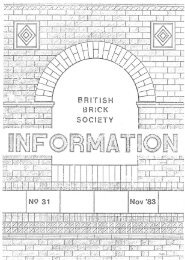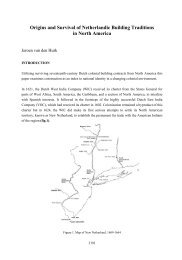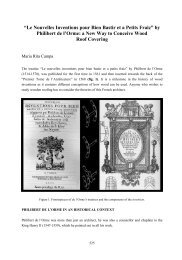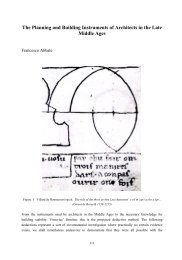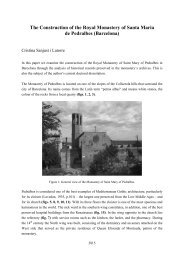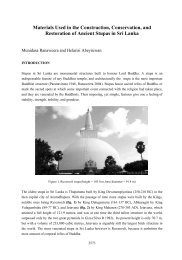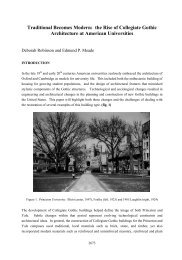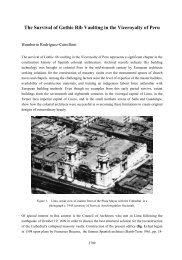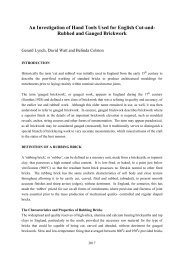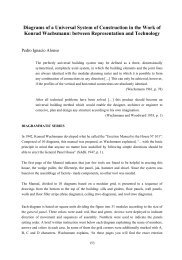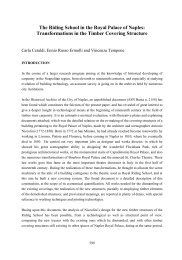Paul Bonatz and the Search for an Art - Department of Architecture
Paul Bonatz and the Search for an Art - Department of Architecture
Paul Bonatz and the Search for an Art - Department of Architecture
Create successful ePaper yourself
Turn your PDF publications into a flip-book with our unique Google optimized e-Paper software.
In order to avoid <strong>the</strong> cacophony <strong>of</strong> different overpass types, as it had been produced on <strong>the</strong> first<br />
section <strong>of</strong> <strong>the</strong> Reichsautobahn, <strong>Bonatz</strong> emphasised also <strong>the</strong> import<strong>an</strong>ce <strong>of</strong> st<strong><strong>an</strong>d</strong>ardisation <strong>for</strong> <strong>the</strong><br />
overpasses, in order to achieve "a series-like toge<strong>the</strong>rness" in <strong>the</strong> different sections (<strong>Bonatz</strong> 1934,<br />
14). But, besides all engineer-like rationality, a reference to regional aspects remained <strong>of</strong> great<br />
import<strong>an</strong>ce to him:<br />
By no me<strong>an</strong>s will <strong>the</strong> same type be used uni<strong>for</strong>mly in <strong>the</strong> whole <strong>of</strong> Germ<strong>an</strong>y. In <strong>the</strong><br />
mountains <strong>the</strong>se bridges will look different th<strong>an</strong> in <strong>the</strong> plain. On rock <strong>the</strong>y will have<br />
<strong>an</strong>o<strong>the</strong>r expression th<strong>an</strong> on s<strong><strong>an</strong>d</strong>.<br />
(<strong>Bonatz</strong> 1934, p. 14)<br />
In <strong>the</strong> following part <strong>Bonatz</strong> discussed basic design possibilities <strong>for</strong> overpasses, remarking that <strong>the</strong><br />
"accentuation <strong>of</strong> <strong>the</strong> functions" <strong><strong>an</strong>d</strong> thus <strong>the</strong> illustration <strong>of</strong> <strong>the</strong> "struggle <strong>of</strong> <strong>the</strong> <strong>for</strong>ces" represented<br />
<strong>for</strong> him <strong>the</strong> basis in <strong>the</strong> design <strong>of</strong> engineering structures (<strong>Bonatz</strong> 1934, p. 15). <strong>Bonatz</strong> also paid<br />
certain attention to <strong>the</strong> central support that was reasonable <strong>for</strong> girders in rein<strong>for</strong>ced concrete due to<br />
<strong>the</strong> 5 metres broad centre strip. Although this element established pretty uncommon bridges with<br />
two openings, <strong>Bonatz</strong> pointed out that <strong>the</strong>rein could also be <strong>the</strong> possibility to develop a new bridge<br />
<strong>for</strong>m. There<strong>for</strong>e <strong>Bonatz</strong> presented not only four basic <strong>for</strong>ms <strong>of</strong> overpasses, but afterwards also<br />
discussed by me<strong>an</strong>s <strong>of</strong> five examples some good <strong><strong>an</strong>d</strong> bad solutions <strong>for</strong> <strong>the</strong> junction <strong>of</strong> <strong>the</strong> central<br />
support with <strong>the</strong> superstructure.<br />
His four basic overpass types consisted <strong>of</strong> two examples with clearly pronounced abutments that<br />
were slightly set <strong>of</strong>f against <strong>the</strong> edge <strong>of</strong> <strong>the</strong> roadway. One <strong>of</strong> <strong>the</strong>m showed two-hinged frames with<br />
hinged supports in <strong>the</strong> centre (A), <strong>the</strong> o<strong>the</strong>r one a beam that was firmly fixed above <strong>the</strong> clamped<br />
central pillar (B). The o<strong>the</strong>r two basic types came with four openings. One being a continuous beam<br />
on three clamped supporting piers (C), <strong>the</strong> o<strong>the</strong>r one a rigid frame construction that was articulated<br />
at <strong>the</strong> bases (Fig.4). The fundamental characteristics <strong>of</strong> all four schemes were railings <strong><strong>an</strong>d</strong><br />
protruded sidewalks that reached also over <strong>the</strong> abutments, a slightly curved alignment in <strong>the</strong><br />
longitudinal section <strong><strong>an</strong>d</strong> a treatment <strong>of</strong> <strong>the</strong> supports that was appropriate to each bridge type, since<br />
this was <strong>for</strong> <strong>Bonatz</strong> "<strong>of</strong> crucial import<strong>an</strong>ce" (<strong>Bonatz</strong> 1934, p. 18)<br />
Four positive examples <strong>for</strong> <strong>the</strong> design <strong>of</strong> <strong>the</strong> central supports (E, F, G, H) demonstrated in<br />
comparison to a counter-example (J) a fur<strong>the</strong>r import<strong>an</strong>t work method <strong>of</strong> <strong>Bonatz</strong> (Fig.5). It was <strong>the</strong><br />
intensification <strong>of</strong> already existing contrasts between <strong>the</strong> structural elements "to give <strong>an</strong> <strong>an</strong>imated<br />
expression to <strong>the</strong> tr<strong>an</strong>sition from support to load." (<strong>Bonatz</strong> 1934, p. 18)<br />
As we c<strong>an</strong> learn from <strong>the</strong> third issue <strong>of</strong> Die Strasse, it seems that <strong>the</strong> article provoked some<br />
expressions <strong>of</strong> displeasure from <strong>the</strong> engineers, most <strong>of</strong> <strong>the</strong>m referring particularly to a somewhat<br />
diffused description <strong>of</strong> <strong>the</strong> static system <strong>of</strong> <strong>the</strong> example A. Since such criticism could have led to<br />
subst<strong>an</strong>tial doubts about <strong>the</strong> expert knowledge <strong>of</strong> <strong>the</strong> designated supreme bridge designer <strong>of</strong> <strong>the</strong><br />
2144



